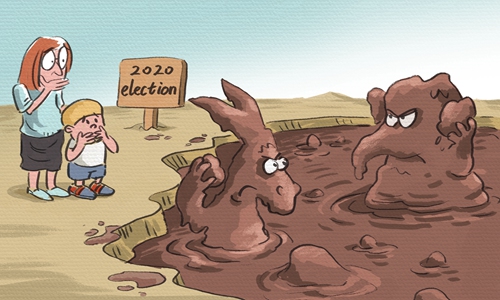New attacks on Chinatowns are blind to the facts

Illustration: Liu Rui/GT
The Chinese Lunar New Year, which always falls in the first or second month of the Gregorian calendar, is normally the busiest time in Chinatowns across the US. Celebrations attract tens of thousands of visitors to these neighborhoods where traditions are best kept. But this year, the most important holiday for Chinese corresponded with the outbreak of the coronavirus in China, which had ignited early racial attacks against Asians.Still, many elected officials went to their local Chinatowns to dine, shop and boost the morale of the local communities and to shoo off unfounded suspicions that the virus had found its way there.
Now these officials have become targets of President Donald Trump and his allies because they encouraged people to support businesses in the Chinatowns, weeks before Trump's March 13 declaration of a national emergency and before the virus got its first deadly grip on the US.
House Speaker Nancy Pelosi is in the middle of this storm. Pelosi visited her local San Francisco Chinatown on February 24, visiting shops and having dim sum for lunch. She said at the time: "That's what we're trying to do today is to say everything is fine here." Adding: "Come because precautions have been taken. The city is on top of the situation."
That was 22 days after Trump imposed restrictions prohibiting travelling from China, and 10 days before San Francisco announced its first two confirmed cases of the virus. Now, two months later, on April 16, Trump tweeted: "Crazy Nancy Pelosi deleted this from her Twitter account. She wanted everyone to pack into Chinatown long after I closed the BORDER TO CHINA. Based on her statement, she is responsible for many deaths. She's an incompetent, third-rate politician!"
Accompanying the tweet was a news segment about Pelosi's Chinatown trip that the Speaker had not posted on her Twitter account.
New York officials who visited Chinatown in early February are facing similar shaming. On his show on March 26, Fox News presenter Tucker Carlson slammed a group of New York officials from the Department of Health including Commissioner Dr. Oxiris Barbot and State senators John Liu and Brian Kavanaugh for staging a news conference on February 2 in the Manhattan Chinatown calling on people to visit shops there and participate in the Lunar New Year Parade to be held later in the month.
That was about a month before New York had its first confirmed case. Soon after the politicians' visit, "people in New York inevitably started to get sick, in some cases very sick. In some cases, they died," said Carlson conflating the two events contrary to known facts. "And then suddenly de Blasio (New York's Mayor Bill de Blasio) was on 'Meet the Press' shrieking that Donald Trump had abandoned the city."
The logic behind the accusations is baffling.
If the local officials had known then what they know now, they certainly would have launched better policies to save more lives and the facts show that calling on people to visit Chinatowns has not contributed to the death toll here.
Data released by New York City on April 16 shows that there were 95.1 non-hospitalized confirmed cases, 82.2 non-fatal hospitalized cases and 34.5 deaths from the coronavirus per 100,000 Asians, the lowest rates among all other ethnic groups.
An interactive map by ProPublica that tracks the COVID-19 positive cases by zip code shows that the Manhattan Chinatown area has had 6.2 confirmed cases per 1,000 people, 59 percent lower than the city's average.
In San Francisco, a similar interactive map run by the city shows that four out of the five zip codes that include parts of Chinatown have either far below average numbers of cases or have so few cases that they don't meet the threshold for an infection rate to be calculated. The other zip code is slightly above the average number of cases for the city.
The fact is the average visitor from China is just as likely to hang out at Fisherman's Wharf in San Francisco or visit the Statue of Liberty in New York than spend a lot time in those cities' Chinatowns. There are a lot of reasons Asians may be doing better during this crisis. But I am going to spare that analysis for another day. With a raging pandemic, a collapsing economy and a looming presidential election, it seems just about everyone in this country is either busy defending President Trump or dissing him.
The political war is getting nastier and nastier.
But the nation's Chinatowns shouldn't be caught in the middle and victimized twice. Chinatowns have suffered a lot during this pandemic, but they are not hotspots of the virus. And anyone who indicates otherwise is either lying or blind to the facts.
The author is a New York-based journalist and Alicia Patterson Foundation fellow. rong_xiaoqing@hotmail.com

